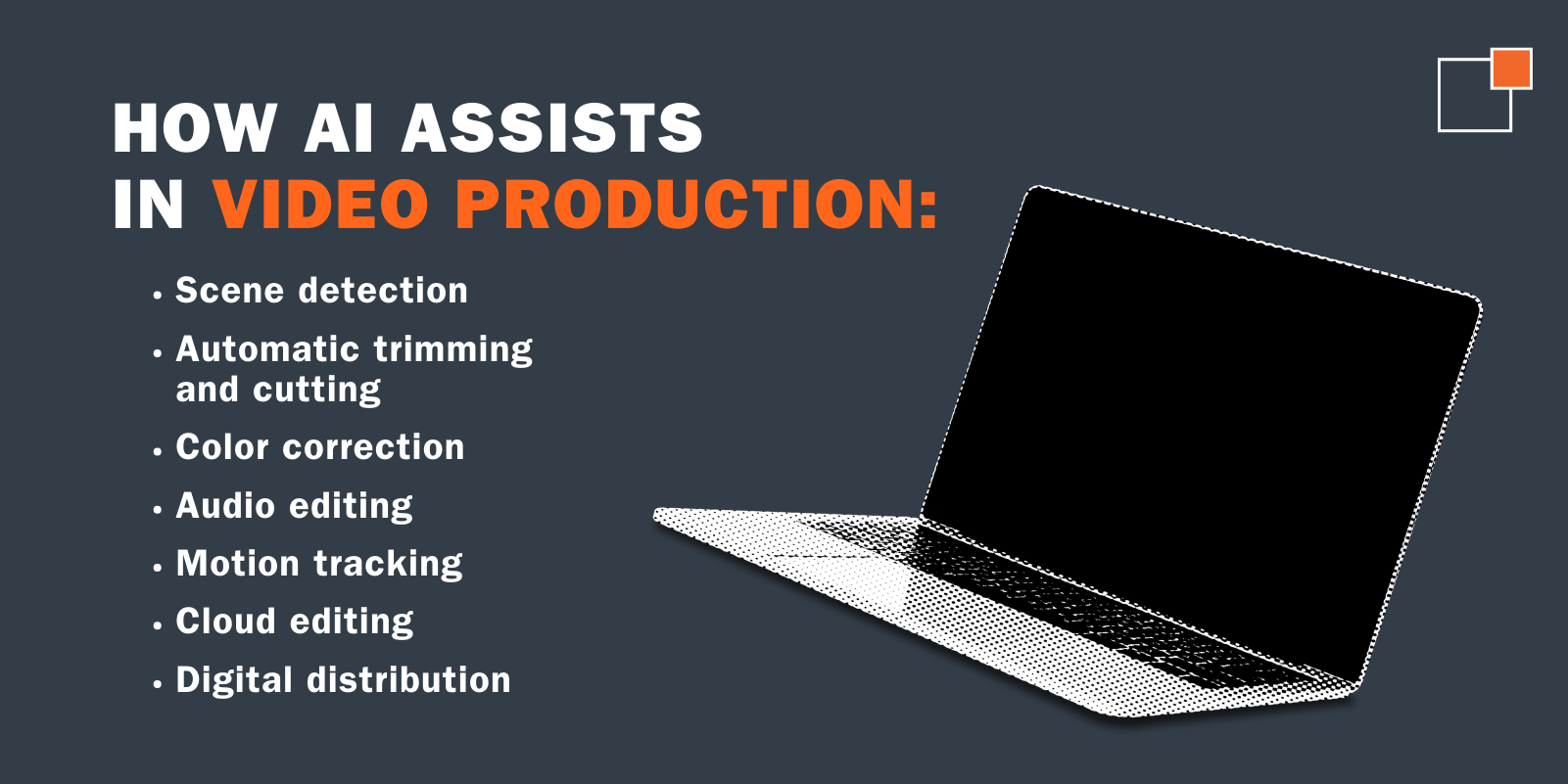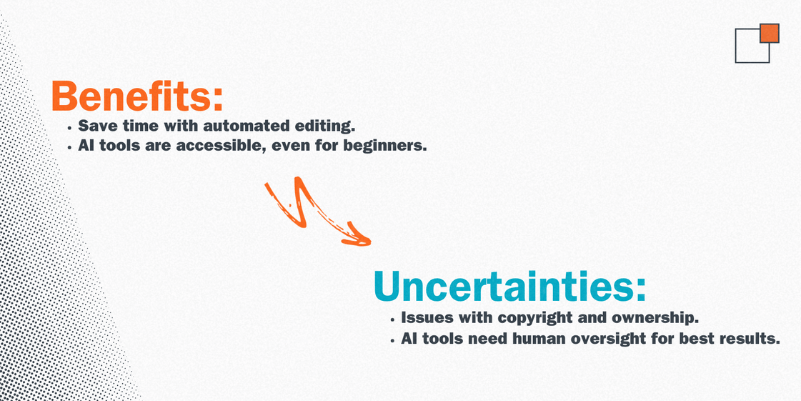HOW AI TOOLS CAN ENHANCE VIDEO PRODUCTION
Reinventing the editing process
Lights, camera, action! The stage is set, the cameras are rolling and AI is stealing the show in the world of video production. From transforming communication to redefining entertainment, it's no secret technology pushes the boundaries of creativity and efficiency across various industries and video production is no exception. With features like automated editing processes and groundbreaking visual effects, AI is changing the game in creating high-quality video content. As we dive further into how to use AI in filmmaking, prepare to be dazzled by the possibilities and innovations reshaping the editing process.

AI in pre-production and planning
Before the cameras even start rolling, AI can work behind the scenes to ensure the first take is as flawless as possible. Here are a few ways AI can help prep your project for success:
-
Script analysis: AI can take a deep dive into your script, not just checking for grammar but analyzing pacing, character arcs and narrative flow. It’ll even give you tips to punch up the pacing or highlight spots where the story drags.
-
Storyboarding: Using natural language processing, AI can read your script and instantly generate visual previews of your scenes. Need help deciding on camera angles, lighting setups or scene transitions? AI’s on it, giving you a sneak peek of your vision.
When AI steps in during pre-production, you're setting yourself up for a smoother shoot and way less chaos post-production.
Viewing AI through a cinematic lens
AI is every filmmaker’s new best friend in the editing room, revolutionizing the process of bringing creative visions to life. Forget the days of slogging through endless editing tasks; with AI by your side, you'll be producing cinematic masterpieces in no time. AI in video production marks the fusion of advanced algorithms with the artistry of filmmaking, where technology seamlessly complements human creativity.
So, how does it all work, anyway? AI algorithms dive headfirst into your video footage, analyze every frame with lightning speed and make editing decisions based on predefined parameters. It's like having a film-savvy robot assistant by your side, ensuring your editing process is efficient and allowing you to focus on your artistic insight.
Here are some features you can use to revamp your video production process:
1. Scene detection
AI swiftly identifies transitions between scenes in video footage, using advanced algorithms to distinguish changes in location, lighting and subject. With the help of AI, we’ve moved past manually scrubbing through endless footage – now, you can sit back and watch as your footage is magically sorted into neat, organized segments, ready for editing with just a click of a button.
2. Automatic trimming and cutting
Whether it's a moment of shaky camera work or an accidental pause in dialogue, AI can seek out our human imperfections and get rid of them. Well, not all of them. But at least the ones that hinder the flow of video content! Meticulously sifting through each frame, AI can find and eliminate awkward pauses and other distractions, leading to a more polished final product. For content aimed at video streaming platforms, this speed and efficiency are essential, making sure you stay on schedule and keep the quality top-notch every time.

3. Color correction
Thanks to AI, every hour can be golden hour as filmmakers can effortlessly enhance the visual quality and customize the mood of videos through color correction. Analyzing factors such as color balance, saturation and lighting conditions, AI identifies areas where colors may appear dull or unbalanced and applies adjustments to achieve vibrant, lifelike tones.
4. Audio Editing
An expert in noise reduction and audio leveling, AI can remove unwanted background noise as well as balance sound levels across different clips to maintain a consistent and clear listening experience. By studying the mood and tone of a video, AI can suggest an appropriate soundtrack or even curate the perfect musical accompaniment.
5. Motion tracking
AI brings a new level of precision to video editing through its excellent motion-tracking abilities. Acting as a virtual cameraperson, AI follows the movement of objects or individuals within the frame. This enables the automated placement of graphics or effects and ensures that these elements stay synchronized with the action.
6. Cloud editing
With AI-powered platforms living in the cloud, your entire team can jump into the same project from wherever they are and edit together in real-time. No more passing giant files back and forth or waiting on feedback loops that feel like they take longer than post-production itself. Whether you're on set, in a coffee shop or halfway across the globe, cloud editing keeps the momentum going—and the content flowing.
7. Digital distribution
Once editing is complete, AI can also help execute your video’s big debut. It knows when your video should drop, where it needs to be and how to make it shine on every platform. By handling metadata, format tweaks and upload timing, AI turns distribution into a smooth, behind-the-scenes operation, so your content shows up looking sharp and ready to perform.

Tools and platforms powered by AI
We’ve established the range of capabilities offered by current AI, but the burning question remains: Where can I access these handy features? Filmmakers have a variety of options to choose from when it comes to utilizing AI in video production. While beta software might not be ready for commercial use just yet, powerhouses like Adobe are leading the charge with AI-powered features that streamline numerous aspects of the editing and production process.
We’ve gathered a list of tools and platforms where you can tap into the potential of AI to revolutionize your video productions:
-
Adobe Premiere Pro: Adobe's Sensei AI technology offers features like Auto Reframe, which automatically adjusts aspect ratios for different platforms, and Scene Edit Detection, which identifies cuts in edited footage.
-
Final Cut Pro: Apple's software incorporates machine learning algorithms for tasks like audio cleanup, color grading and creating Smart Collections—a tool for organizing media based on content.
-
Blackbird: This cloud-based video editing platform employs AI for rapid editing, allowing for real-time collaboration and quick turnaround times.
-
OpenAI’s Sora: Newer to the scene, Sora is a text-to-video model that can generate high-quality videos up to a minute long based on the user’s prompt.
-
Runway: AI tools for video editing, visual effects and text-to-video generation, perfect for enhancing production quality with minimal effort.
-
Magisto: Magisto automates scene detection, color correction and sound syncing to make video editing quick and efficient.
Benefits and remaining uncertainties
It’s clear AI changes the game in terms of saving time. Automating tedious video editing tasks, AI makes the entire video editing process more efficient. It’s also accessible, meaning individuals with varying levels of editing experience can use AI to create professional-quality videos without the need for extensive technical expertise. Equipped to handle large volumes of video content efficiently, AI editing tools are suited for large projects.

However, some uncertainties regarding the technology continue to linger. Copyrighting is one of the primary concerns about the use of AI. Just like the transition from film to digital photography sparked debates, the rise of AI in video production has raised questions about ownership and creative control.
It’s also important to note that AI isn’t always consistent, and any work edited with AI should still be reviewed and fine-tuned by human editors to ensure quality and accuracy. Ultimately, navigating AI-assisted video editing requires a careful balancing act between innovation and regulation.
The future of filmmaking
As AI technology continues to advance, it will undoubtedly play a central role in shaping the future of the video production industry, transforming the way content is created, consumed and distributed. In just the past year, the strides made in AI have been nothing short of astounding, altering everything from automating editing processes to pioneering text-to-video prompting technology. We’re also seeing a rise in immersive and interactive video experiences, blending storytelling with real-time user engagement. As our creative ally, AI is driving us into a new era of video production, and we’re thrilled to see where it goes!
Learning to use new AI tools and work through their quirks can be challenging. If you’re looking for guidance and support as you incorporate AI into your video production, look no further. We’re excited to help make your editing process smoother and more efficient! Send us a message to get the film rolling!

About the Author
Lexie Febel is a Content and PR Coordinator at thunder::tech. Her favorite pastime includes being cozied up with her cats while getting lost in the pages of a compelling book.
Related Blog & News
thunder::tech Earns 5th Inc. 5000 Honor
Blog | Aug 11, 2025Step-by-Step Guide To Video Marketing Strategies For Businesses
Blog | Apr 25, 2025Award-Winning Digital Marketing & Design at thunder::tech
Blog | Apr 23, 2025How Video SEO Boosts Rankings: Does Video Really Help SEO?
Blog | Mar 13, 2025Ready to see what we can do for you?
Let's connect and explore how we can amplify your brand.